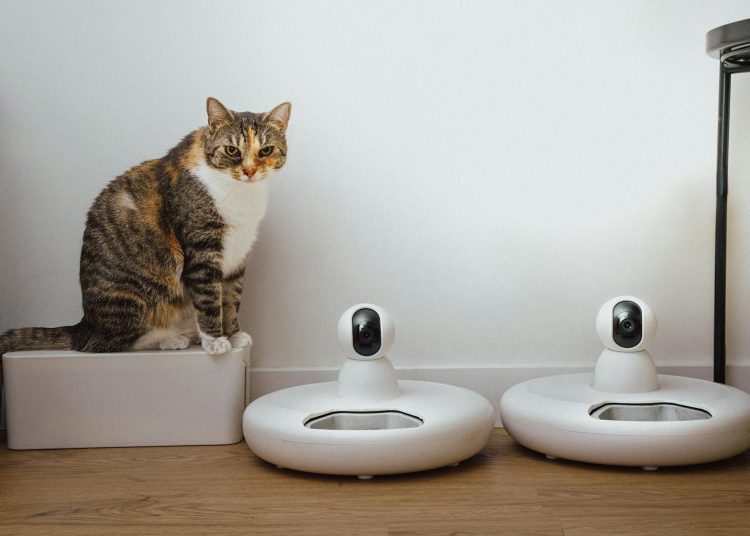For pet owners, ensuring the safety and well-being of their beloved furry friends is always a top priority. However, work schedules, travel, and other daily responsibilities can make it challenging to keep an eye on pets 24/7. Fortunately, advancements in pet technology have made it easier than ever to monitor pets remotely and ensure their safety. Pet monitoring systems are designed to provide pet owners with peace of mind, allowing them to keep track of their pets’ activities, health, and safety from anywhere. In this article, we’ll explore the different types of pet monitoring systems, how they work, and why they are an essential tool for modern pet care.
Smart Pet Cameras: Keeping an Eye on Your Pet
Smart pet cameras are among the most popular pet monitoring solutions available today. These cameras allow pet owners to keep an eye on their pets when they are not at home by providing live video feeds that can be accessed through a smartphone app. With features like two-way audio, treat dispensers, and motion detection, pet cameras provide much more than just a visual check-in—they offer a way for pet owners to interact with their pets remotely and ensure they are safe and comfortable.
Many pet cameras come equipped with two-way audio, allowing pet owners to speak to their pets through the camera. This feature is particularly helpful for pets that experience separation anxiety, as hearing their owner’s voice can provide comfort and reassurance. Some cameras also include treat dispensers, enabling pet owners to reward their pets for good behavior even when they’re not at home. This level of interaction helps maintain the bond between pets and their owners, reducing the stress and loneliness that can come with being left alone for extended periods.
Motion detection is another valuable feature found in smart pet cameras. When the camera detects movement, it can send an alert to the owner’s smartphone, allowing them to check in and make sure their pet is safe. This feature can also be useful for identifying potential safety hazards, such as a pet getting into a restricted area or knocking over household items. By providing real-time alerts, smart pet cameras help pet owners respond quickly to any potential issues.
GPS Trackers: Keeping Pets Safe and Secure
GPS trackers are an essential tool for pet owners with adventurous pets that love to explore. These small devices attach to a pet’s collar and use GPS technology to track their location in real-time. By connecting to a smartphone app, pet owners can see exactly where their pet is at any given moment, giving them peace of mind knowing that their furry friend is safe.
One of the most valuable features of GPS trackers is the ability to set up virtual boundaries, also known as geo-fencing. Pet owners can define a safe area for their pet, such as the yard or neighborhood, and receive alerts if their pet leaves this designated area. This feature is especially useful for pets that tend to wander or escape, as it allows owners to act quickly and bring their pet back to safety before they get too far.
GPS trackers can also be helpful for preventing pet theft. If a pet is taken, the GPS tracker can provide real-time location information, making it more likely that the pet will be recovered quickly. The visible presence of a GPS tracker may also act as a deterrent, as potential thieves may be less likely to target a pet that can be easily tracked.
Health Monitoring Systems: Keeping Tabs on Well-Being
In addition to monitoring a pet’s location, some pet monitoring systems are designed to track health metrics and ensure pets are staying healthy. Wearable health trackers, such as smart collars, collect data on a pet’s activity levels, sleep patterns, heart rate, and other vital signs. These devices use sensors to gather information about the pet’s well-being and transmit the data to a smartphone app, where pet owners can view detailed reports and insights.
Health monitoring systems are particularly useful for older pets or those with chronic health conditions that require regular observation. By tracking key health metrics, these devices can detect changes in a pet’s behavior or vital signs that might indicate an underlying health issue. If the system detects something unusual, it can send an alert to the pet owner, prompting them to seek veterinary attention. This early detection can make a significant difference in catching health problems before they become serious and ensuring pets receive timely care.
Interactive Smart Toys: Keeping Pets Entertained and Safe
Boredom and lack of mental stimulation can lead to destructive behaviors in pets, which is why interactive smart toys are an important part of pet monitoring. These AI-powered toys are designed to keep pets entertained and engaged, even when their owners are not at home. By responding to a pet’s actions and creating dynamic play experiences, these toys help prevent boredom and reduce the risk of destructive behaviors, such as chewing on furniture or excessive barking.
For example, some interactive toys are equipped with sensors that detect a pet’s movement and respond by moving, making sounds, or dispensing treats. These toys can adapt to a pet’s behavior, creating personalized play routines that cater to their preferences. By providing both physical exercise and mental stimulation, interactive smart toys contribute to a pet’s overall well-being and safety, ensuring they stay occupied and out of trouble when left alone.
Environmental Sensors: Creating a Safe Space for Pets
Environmental sensors are another valuable component of pet monitoring systems, helping pet owners create a safe and comfortable environment for their pets. These sensors can detect changes in temperature, humidity, and air quality, ensuring that pets are comfortable and safe from environmental hazards. For example, if the temperature in the house becomes too hot or too cold, the sensor can send an alert to the pet owner, prompting them to adjust the thermostat or take other measures to ensure their pet’s comfort.
Environmental sensors can also detect potential hazards, such as smoke or carbon monoxide, and send alerts to the pet owner’s smartphone. This level of monitoring is especially important for pet owners who may not be home during the day, as it allows them to take action to protect their pets in case of an emergency. By creating a safe environment, these sensors help pet owners ensure their pets’ well-being and prevent accidents or health issues caused by environmental factors.
Telehealth and Virtual Vet Consultations
Access to veterinary care is a crucial part of ensuring a pet’s safety and well-being, and telehealth services are making it easier for pet owners to connect with veterinarians from the comfort of their homes. Telehealth platforms designed for pets allow pet owners to consult with veterinarians through video calls, discuss health concerns, and receive advice without needing to visit a clinic in person. Some pet monitoring systems integrate with telehealth services, providing veterinarians with access to data collected by wearable health trackers.
For example, during a virtual consultation, the veterinarian can use data from a pet’s health monitoring device to get a detailed overview of their recent activity, vital signs, and behavior. This information helps the veterinarian make more informed decisions about the pet’s care and can reduce the need for in-person visits for minor health concerns. Telehealth services provide pet owners with greater access to veterinary care, ensuring that pets receive timely attention when needed.
Choosing the Right Pet Monitoring System
With so many pet monitoring systems available, choosing the right one for your pet can be overwhelming. Here are some key factors to consider when selecting a pet monitoring system:
- Type of Monitoring: Consider what aspects of your pet’s safety you want to monitor. If you’re concerned about your pet’s location, a GPS tracker may be the best option. If you want to keep an eye on their health, consider a wearable health tracker or a smart camera with health monitoring features.
- Features and Functionality: Look for a monitoring system that offers the features you need, such as two-way audio, treat dispensing, motion detection, or health tracking. Make sure the system is compatible with your smartphone and easy to use.
- Pet Size and Comfort: The size and comfort of the monitoring device are important considerations, especially for smaller pets. Choose a device that is lightweight and comfortable for your pet to wear without causing any discomfort.
- Durability and Battery Life: Pets can be tough on their gear, so it’s important to choose a monitoring system that is durable and waterproof. Additionally, consider the battery life of the device, especially if you plan to use it for extended periods. A longer battery life means less frequent charging and more consistent monitoring.
- Subscription Plans: Some pet monitoring systems, particularly GPS trackers, require a subscription plan to cover the cost of cellular data. Make sure to factor in the cost of the subscription when choosing a system, and look for flexible plans that fit your budget and needs.
The Benefits of Pet Monitoring Systems
Pet monitoring systems offer numerous benefits that make them an essential tool for modern pet care. They provide pet owners with peace of mind, knowing that they can check in on their pets at any time and ensure they are safe and comfortable. Whether it’s using a smart camera to interact with a pet, tracking their location with a GPS device, or monitoring their health with a wearable tracker, pet monitoring systems help pet owners stay connected to their furry friends and provide the best possible care.








